|
 Hygrophorus segregatus Hygrophorus segregatus
BiostatusPresent in region - Indigenous. Endemic
Images (click to enlarge)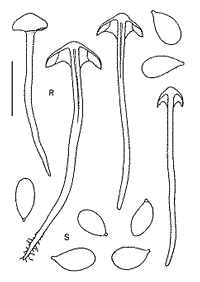
Caption: Fig. 43 Hygrophorus segregatus Horak (R-S: PDD
27225, type): R. basidiomes. S. spores. | 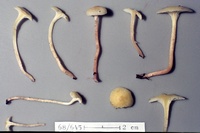
Caption: ZT68-645
Owner: E. Horak: © Creative Commons Attribution-Noncommercial 3.0 New Zealand | 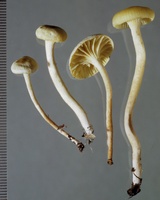
Caption: ZT71-082
Owner: E. Horak: © Creative Commons Attribution-Noncommercial 3.0 New Zealand | 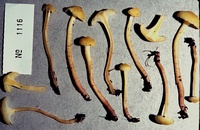
Caption: ZT1116, Holotype
Owner: E. Horak: © Creative Commons Attribution-Noncommercial 3.0 New Zealand | 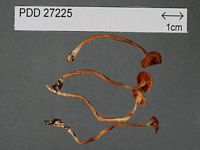
Caption: Dried type specimen
Owner: Herb PDD |
Article: Horak, E. (1990). Monograph of the New Zealand Hygrophoraceae (Agaricales). New Zealand Journal of Botany 28(3): 255-306 (http://www.rsnz.org/publish/abstracts.php).
Description: Pileus -25 mm, hemispherical to convex with broad umbo, campanulate becoming
plane with distinct papilla; whitish, pale yellow or yellow, darker in centre,
red or orange colours absent; viscid when moist becoming smooth in dry condition,
membranaceous, striate towards margin. -Lamellae 8-14 (1-3) decurrent to arcuate,
rather distant, up to 3 mm wide, occasionally forked near margin or with anastomoses;
pale yellow to yellow, edges concolorous, entire. - Stipe 25-80 x 1.5-3 mm,
cylindrical or gradually tapering towards base; upper half concolorous with
pileus, turning apricot-orange-pink towards and at base; dry, smooth, basal
tomentum white, occasionally substrigose, solid becoming fistulose with age,
single. - Context yellow (in pileus and apex of stipe), pink-orange in base
of stipe, brittle. - Odour and taste not distinctive. - Chemical reactions on
pileus: KOH - negative. - Spore print white.
Spores 6.5-8 x 3.5-4.5 um, elliptical to drop-shaped, smooth, hyaline, inamyloid.
- Basidia 35-55 x 5-6 um, 4-spored. -Cystidia absent -Pileipellis an ixocutis
of cylindrical hyphae (2-6 um diam.), pale brown (KOH) plasmatic and/or encrusting
pigment; clamp connections present (Pl. 1, Fig. 7).
Habitat: ECOLOGY: Scattered; saprobic on soil among litter in broadleaved-conifer forests
(Kunzea ericoides, Elaeocarpus, Podocarpus, Dacrydium, Agathis, Cyathea).
June-July.
Distribution: DISTRIBUTION: NZ (NA, SA).
Notes: ETYMOLOGY: segregatus = separated, isolated.
This new taxon is characterised by its slender yellow basidiomes. The base
of the stipe slowly turns apricot or orange. Hygrophorus segregatus shares this
feature with H. salmonipes (Stev.) and therefore in the field these two taxa
are readily confused. Microscopically, however, these similar-looking agarics
are distinguished at once by the size of the spores.
|